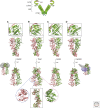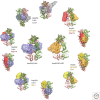Structure, Function, and Regulation of the Hsp90 Machinery
- PMID: 30745292
- PMCID: PMC6719599
- DOI: 10.1101/cshperspect.a034017
Structure, Function, and Regulation of the Hsp90 Machinery
Abstract
Heat shock protein 90 (Hsp90) is a molecular chaperone involved in the maturation of a plethora of substrates ("clients"), including protein kinases, transcription factors, and E3 ubiquitin ligases, positioning Hsp90 as a central regulator of cellular proteostasis. Hsp90 undergoes large conformational changes during its ATPase cycle. The processing of clients by cytosolic Hsp90 is assisted by a cohort of cochaperones that affect client recruitment, Hsp90 ATPase function or conformational rearrangements in Hsp90. Because of the importance of Hsp90 in regulating central cellular pathways, strategies for the pharmacological inhibition of the Hsp90 machinery in diseases such as cancer and neurodegeneration are being developed. In this review, we summarize recent structural and mechanistic progress in defining the function of organelle-specific and cytosolic Hsp90, including the impact of individual cochaperones on the maturation of specific clients and complexes with clients as well as ways of exploiting Hsp90 as a drug target.
Copyright © 2019 Cold Spring Harbor Laboratory Press; all rights reserved.
Figures



References
Publication types
MeSH terms
Substances
LinkOut - more resources
Full Text Sources
Miscellaneous
